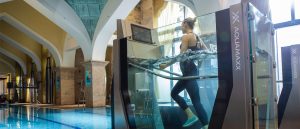2020 官网升级中!现在您访问官网的浏览器设备分辨率宽度低于1280px请使用高分辨率宽度访问。
Hydrotherapy pools are distinct from regular swimming pools, being much warmer and having jets built in for massage purposes. Baths, hot tubs and whirlpools are also considered forms of hydrotherapy.
Immersing in warm water relaxes muscles and relieves pain. It can also reduce stress and anxiety and help to relieve labour pains.
Warm Water
The water in a hydrotherapy pool is much warmer than a typical swimming pool. This temperature makes it more relaxing and therapeutic. The warm water also soothes the muscles and helps to reduce pain. It can also help to heal injuries and promote bodily functions such as circulation and respiration.
The viscosity of the water in a hydrotherapy pool creates resistance that can be used for exercise without overloading muscles or stressing joints. This makes it a good alternative to working out with weights. You can use floats, noodles or even dumbbells in a hydrotherapy pool to increase resistance and challenge your muscles.
The warm water in a hydrotherapy pool creates a sedative effect on the muscles and the mind as well. It can lower cortisol levels and raise serotonin. This combination can have a positive impact on mood and relieve stress. It can also improve joint flexibility and mobility. Exercise in a hydrotherapy pool can also help to alleviate pain and improve quality of life.
No Pain
Hydrotherapy pools offer a range of benefits for those with limited mobility or pain. They are often used alongside a programme of exercises and movements that have been prescribed by a GP or therapist and can help build confidence in moving in water.
The buoyancy of the water reduces pressure on bones and joints and allows movement to be completed without straining. The temperature of the water also introduces heat which numbs or overrides the sensation of pain, helping to alleviate discomfort and support the body’s recovery.
Many hydrotherapy pools feature massage jets to target specific parts of the body. These soothing jets of water can be turned up or down to increase or decrease their intensity, offering a low-intensity massage that relaxes muscles and promotes emotional wellbeing. The buoyancy of the water also helps to strengthen muscle and improve flexibility, making it easier for people with painful conditions to exercise safely without putting too much strain on their bodies.

Relaxation
For most of us, a hot bath or swimming pool is the ideal place to relax and unwind. However, a hydrotherapy pool is designed to take things even further than that. These specialist pools typically have jets of water aimed at different parts of the body to act as a low-intensity massage, soothing and releasing tension. These are also known as vitality pools and they can help improve the overall wellness of a person.
In addition, the weightlessness of warm water provides a feeling of ease and support which can be very beneficial for those with joint and muscle pain. It can also prompt the release of endorphins, the body’s natural pain relievers.
We recently helped a client who had their local hydrotherapy pool threatened with closure. The CSP has a number of resources that can help you promote and protect your services, including downloadable template letters to use when contacting decision-makers about the issue.
Exercise
Hydrotherapy pools are popular at spas as well as being available for home use because they offer both the benefits of exercise and relaxation. They can help increase muscle strength as the density of the water provides resistance to movements. The warm temperature helps re-energize muscles and promotes blood circulation to the joints. The calming and invigorating characteristics of hydrotherapy pools are also known to alleviate pain from conditions like fibromyalgia.
The water in a hydrotherapy pool is typically set to higher temperatures than a swimming pool, and the humidity is usually increased too. This creates a warm and inviting environment that can be enjoyed by all. The combination of soothing water temperatures and jets that can be used to self-massage the body, along with the weightlessness of being in the water means you can enjoy the benefits without straining your body too much. This is why they are often preferred over regular swimming pools and other fitness facilities for people with injuries or aches and pains.